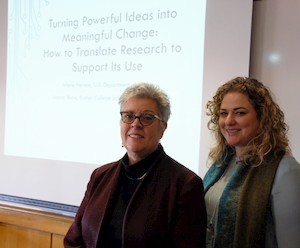
Jolene Hernon (left) and Jessica Shaw (right)
At the Boston College School of Social Work, we often refer to the imperative for our community to advocate for and create lasting impact, both in our daily interactions with those living on the margins, and on the macro level, as citizens and professionals devoted to molding policy. Sometimes, though, it can be hard to know just what are the best ways of making an impression with those who are currently in positions of power.
On November 11th, the School was honored to welcome a professional whose job is to do just this, and at the highest levels of government – Jolene Hernon, Communications Director, U.S. Department of Justice, National Institute of Justice. Hernon spoke on “Turning Powerful Ideas into Meaningful Change: How to Translate Research to Support its Use,” offering specific techniques to the social worker or academic seeking to advocate for new policy based on study findings. Assistant Professor Jessica Shaw hosted the event, and also offered her own unique experience presenting her research on sexual assault to a variety of audiences in diverse settings, including the White House.
“The most important thing to know when talking to decisionmakers,” said Hernon, “is that it’s never about what you know, or how much you know, but instead, it’s about who you’re talking to. Know who they are, and what they need or want, and then give it to them in the form of a good story.”
Hernon offered five principal techniques for doing this successfully:
- It’s about the audience.
- Keep it short and simple – even if you’re scheduled 30 minutes, it could easily become five if a crisis happens. Always have your elevator speech ready. Rank your goals, and start with the one that is most important.
- Practice, edit, delete. Over and over.
- Talk slowly even if you’re pressed for time (focus on condensing the message itself, not the speed with which you present it).
- It’s about the audience (repetition intended, this is the most important).
Hernon referenced two military acronyms as a guide: Bottom Line Up Front and Keep it Simple Stupid, recognizing that the “stupidest person with regards to your subject matter may have a law degree from Harvard.”
“Elected officials are not like you,” she said. “They have to be able to grasp a surface-level understanding of a zillion things, and are unlikely to possess the depth of expertise in a single topic like you do. Don’t go into anything in depth, just provide the bottom line.”
Shaw has diverse experience in getting this bottom line across to different groups. During the event, she explained how she has neatly packaged her dissertation on police response to sexual assault for groups ranging from colleagues in academia (a 1 hour presentation), to police executives (40 minutes), and to federal staffers at the White House (12 short minutes).
“Going in, you need to know what your audience already knows, and meet them where they are so that you can walk forward together, “she explained. “But be firm in your own motivations in relation to the content. If you don’t package the ideas as you want, they may very well walk away with a message that is not the one you’d like them to walk away with.”
Resources for “making your case,” courtesy of Hernon:
Article: “The Needless Complexity of Academic Writing,” by Victoria Clayton, The Atlantic, October 26, 2015.
YouTube class: “From Aristotle to South Park” by Randy Olson for AAAS and the Union of Concerned Scientists. How to tell a story, give your project a narrative, and create a hook.
Books: Made to Stick: Why Some Ideas Survive and Others Die, but Chip and Dan Heath (2007)
The Speaker’s Compact Handbook by Sprague and Stewart (2011)

